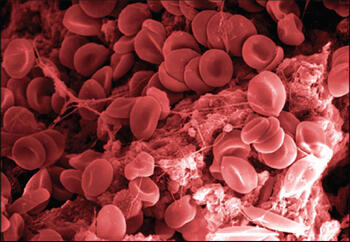Sept. 11, 2007
FDA approves use of compound that can stop severe bleeding in minutes
Use in combat anticipated by late fall
Share this story
Video Clip 1: A better chance of survival
Video Clip 2: Beyond the battlefield

A lightweight, granular, dressing compound developed and studied by Virginia Commonwealth University researchers that quickly stems high-pressure bleeding in moderate to severe wounds has received FDA approval and will soon be used in combat.
VCU researchers have been studying the compound – WoundStat – and say federal approval is good news for soldiers and civilians alike, since the product is easy to carry and can be applied on the spot.
“Uncontrolled bleeding continues to be the primary cause of death on the battlefield,” said Kevin Ward, M.D., a VCU emergency physician and associate director of the VCU Reanimation Engineering Shock Center – VCURES. “After years of research we’ve developed a versatile and robust material that is specifically suited to treat the tremendously complex wounds of war under very demanding environmental conditions. The material is both absorbent and adherent which helps to quickly stop bleeding while simultaneously facilitating clotting.”
The patent-pending technology behind WoundStat is the result of more than three years of study and development by VCURES researchers. The university center not only conducts research on micro-circulatory technologies, but also plays a key role in training Special Operation Combat Medics in the U.S. military. VCU licensed the technology behind WoundStat to TraumaCure Inc. of Bethesda, Md. The compound is expected to be available for field use by the late fall.
“The FDA’s speedy approval of WoundStat means that we can get it more quickly into the hands of those who need it most today—our warfighters in harm’s way around the world,” said Devinder S. Bawa, chief executive officer of TraumaCure, the maker of WoundStat. “The product’s effectiveness is particularly important with core body wounds that a tourniquet can’t reach. We believe that WoundStat has the potential to provide the military with another important tool to minimize battlefield deaths caused by hemorrhaging.”
A recently published study in the Journal of Trauma compared WoundStat to other blood-clotting agents. Results found WoundStat performed better at securely stopping potentially deadly arterial hemorrhaging in three minutes, and continued to do so for at least two hours.
Both U.S. military and foreign military allies have expressed interest in the new product, but WoundStat’s benefits may extend far beyond the battlefield.
“It will provide a life-saving tool in everyday civilian emergency situations as well as where advanced medical care is not immediately available, such as accidents in remote terrain and on the high seas, or in unexpected disasters such as earthquakes or explosions, said retired Lt. Gen. Ronald Blanck, DO, former Surgeon General of the Army.”
Along with Ward, VCURES researchers Robert Diegelmann, Ph.D., Department of Biochemistry and Gary Bowlin, Ph.D., Department of Biomedical Engineering are the inventors of the WoundStat technology.
Subscribe to VCU News
Subscribe to VCU News at newsletter.vcu.edu and receive a selection of stories, videos, photos, news clips and event listings in your inbox.










